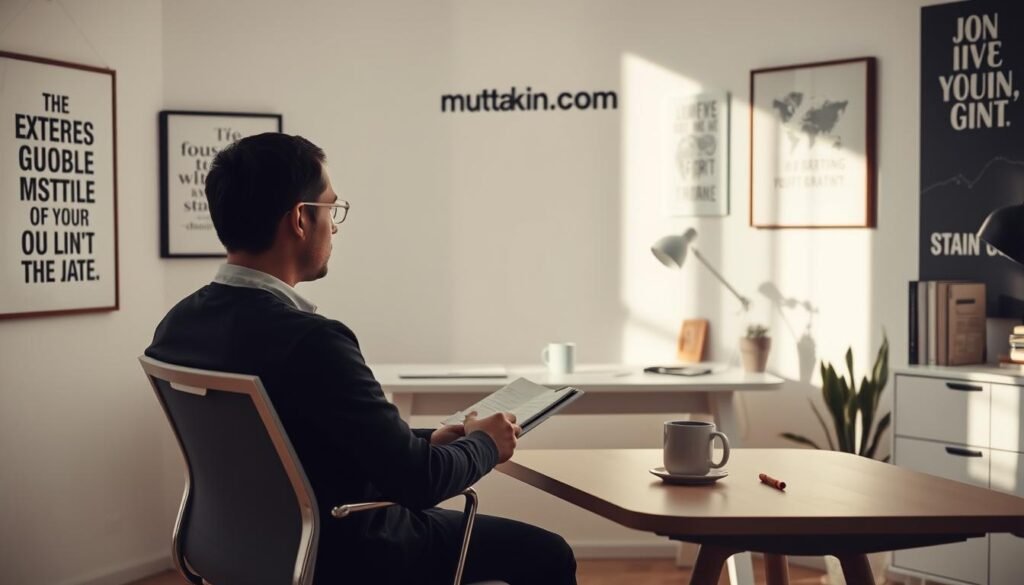Mastering self-awareness: Our step-by-step guide helps you pinpoint your faults and turn them into your greatest assets.
Learn from Your Faults: A Guide to Identifying Mistakes
Successful people don’t hide from their mistakes. They actively seek them out. Identifying faults is key to self-improvement. Leaders like Elon Musk and Sheryl Sandberg share their mistakes to grow.
Research shows self-awareness is crucial for success. It drives 83% of top teams, according to LinkedIn’s 2023 report. This guide shows how facing mistakes helps us grow.
Ignoring mistakes holds us back. Studies show strong self-awareness leads to better job satisfaction and relationships. This article will teach you how to use criticism to improve. You’ll learn to spot blind spots, view failures as chances to grow, and build resilience through honest reflection.

Key Takeaways
- Self-awareness boosts career and relationship success.
- Mistakes are unavoidable but can be turned into growth chances.
- Effective self-assessment needs courage and structured practices.
- Denial and defensiveness slow down personal growth.
- Forgiving past mistakes helps us move forward.
The Power of Self-Awareness in Personal Development
Self-awareness is key to personal growth. It shows us our strengths and weaknesses, helping us get better. Leaders who know themselves well do 32% better, Harvard Business Review found. Psychologist Tasha Eurich says those who know themselves make decisions 40% quicker, showing its importance.
Understanding the Connection Between Self-Awareness and Success
Self-awareness helps in work and personal life. For example, CEOs who know themselves well build trust with their teams. A 2022 Gallup study found employees with self-aware bosses are 3x more likely to be engaged. This way, mistakes become chances to learn, not failures.
Why Many People Avoid Looking at Their Own Faults
- Ego protection: Admitting flaws feels like admitting failure.
- Cognitive dissonance: The discomfort of holding conflicting beliefs.
- Fear of judgment: Worrying others will view them as incompetent.
The Psychological Benefits of Embracing Imperfection
“Imperfection is the first step toward change.” – Brené Brown
Accepting flaws lowers anxiety and builds strength. People who own up to mistakes form real connections. Athletes like Michael Phelps say learning from mistakes, not avoiding them, led to their wins. This mindset changes how we view mistakes.
“By Searching for Your Own Faults, You Can Identify Your Mistakes”
Finding your own faults is key to lasting growth. It moves your focus from what others think to what you truly know. This way, you learn from yourself, not just from failures.
Ancient thinkers like Socrates believed in looking inward first. They saw self-reflection as the start to wisdom.
Socrates taught that true knowledge begins with acknowledging, ‘I know nothing.’ This humility drives discovery.
Looking for your own faults is different from waiting for others to point them out. Thomas Edison, for example, saw every failure as a step closer to success. He wrote down thousands of ‘failures’ in his notebooks.
Companies like Toyota also focus on finding and fixing flaws. They see mistakes as chances to get better. This shows that looking for mistakes can lead to growth.
Looking for your own faults helps you avoid being defensive. It’s about being curious, not feeling guilty. By identifying your mistakes early, you turn setbacks into learning opportunities.
This approach is backed by modern psychology. Studies show that self-assessment makes you stronger and more adaptable. The aim is to learn and grow, not to be perfect.
The Psychology Behind Self-Reflection and Fault Recognition
Self-reflection means facing our own biases that twist reality. These mental tricks, like confirmation bias and self-serving bias, hide our mistakes. For example, the Dunning-Kruger effect makes us think we’re better than we are, making it hard to see our errors.
Cognitive Biases Blocking Clarity
- Confirmation bias: Looks for proof that backs up what we already believe, ignoring the truth.
- Self-serving bias: Credits ourselves for wins but blames others for losses.
- Dunning-Kruger effect: Thinks we know more than we really do, leading to poor judgment.
Overcoming Denial and Defense Mechanisms
Denial and blaming others protect us from pain. To overcome, create a safe space, like writing in a journal. Ask yourself: “What shows my beliefs might be wrong?” This helps us grow instead of blaming.
Emotional Intelligence and Fault Recognition
Being aware of our emotions helps us see our mistakes. Mindfulness and meditation build our emotional strength. This lets us accept our errors without beating ourselves up. Learning to manage our feelings turns shame into a chance to improve.
“The first step to change is awareness. The second step is acceptance.” —Nathaniel Branden
Establishing a Productive Self-Evaluation Practice
Starting a good self-evaluation routine means being clear. It’s not about being too hard on yourself. Instead, it’s about being fair and kind. This helps you grow by turning your thoughts into real actions.

- Schedule Time: Make time each week, like 20 minutes. Use a calendar to remember.
- Choose Methods: Mix journaling with feedback from people you trust.
- Define Focus Areas: Focus on work, relationships, and health equally.
- Create a Space: Find a quiet spot with few distractions.
Keep track of how you’re doing with clear goals. For instance:
| Area | Metrics |
|---|---|
| Work | Meeting project deadlines, getting good reviews from peers |
| Relationships | Talking to loved ones every week |
| Personal Growth | Exercising every week, getting enough sleep |
But, things like being too busy or feeling uncomfortable can stop you. Here’s how to keep going:
- Do quick “micro-reflection” sessions if you’re short on time
- Start with neutral thoughts before you criticize
- Give yourself rewards for sticking with it
Being consistent makes self-evaluation a habit. It’s like learning a new skill. Small steps add up, helping you grow and overcome perfectionism.
Effective Techniques for Honest Self-Discovery
Discover yourself deeper with proven methods. These strategies help you see clearly, without judgment. They reveal blind spots that are key to growing personally.
Journaling Methods That Reveal Hidden Patterns
Keep track of your actions and feelings with writing:
- Stream-of-consciousness writing: Write freely for 10 minutes daily without editing.
- Guided prompts: Use questions like “What triggered my frustration today?” or “How did I respond to challenges?”
- Habit logs: Note recurring decisions and their outcomes in a template like this:
| Time | Action | Emotion | Outcome |
|---|---|---|---|
| 9 AM | Interrupted colleague’s idea | Anxious | Team tension |
Soliciting and Processing Feedback Constructively
Get outside views without getting defensive:
“Feedback is a mirror held to your blind side.” – Marshall Goldsmith
Ask mentors or peers: “What patterns do you notice in my work style?” instead of vague “How am I doing?” Use this response framework:
- Repeat their feedback verbatim (“You said I interrupt frequently”).
- Ask clarifying questions (“Could you share an example?”).
- Decide which 1-2 points to address first.
Meditation and Mindfulness Approaches for Deeper Insight
Practice observing without judgment with techniques like:
- Body scan meditation: Notice physical sensations linked to emotions (e.g., clenched jaw during criticism).
- Loving-kindness meditation: Replace self-criticism with phrases like “May I release this pattern.”
Start with 5-minute daily sessions using apps like Headspace or Insight Timer. As you get better, try 20-minute sessions focusing on breath analysis.
Transforming Identified Mistakes into Growth Opportunities

Turning mistakes into stepping stones for personal growth needs clear action and tracking. After finding areas for improvement, making plans and tracking progress helps in lasting self-improvement.
Creating Actionable Improvement Plans
Begin by turning flaws into goals you can act on. Use SMART (Specific, Measurable, Achievable, Relevant, Time-bound) to make plans:
- Example 1: For public speaking anxiety: “Deliver a 5-minute presentation weekly, record progress, and seek feedback.”
- Example 2: For time management: “Break tasks into 30-minute blocks with a digital timer to track focus periods.”
| Goal | Action Steps | Metrics |
|---|---|---|
| Enhance communication skills | Weekly role-play exercises | Peer feedback ratings |
| Reduce procrastination | Set 2-hour daily focus sessions | Completed tasks per day |
Measuring Progress Through Self-Reflection Milestones
Keep track of growth with regular check-ins every two weeks. Change plans if needed. Celebrate small wins to keep motivation up:
“Growth thrives when accountability meets adaptability,” says Harvard’s Center for Adult Development.
Use tools like journaling apps or calendar reminders to log progress. For example, a professional improved client interactions through weekly surveys. They saw a 40% increase in satisfaction scores in three months.
Common Pitfalls in the Fault-Finding Process
Looking for your own faults can help you spot mistakes. But, some habits can slow you down. To stay on track, it’s key to be aware of yourself. Here are ways to dodge common mistakes:
| Pitfall | What Happens | Fix |
|---|---|---|
| Excessive self-criticism | Burns out motivation | Pair criticism with gratitude for strengths |
| Confirmation bias | Ignores positive traits | Track behaviors in a journal to see full patterns |
| Cherry-picking evidence | Focuses on minor flaws | Set time limits for reflection to avoid overanalysis |
| Comparing to others | Misdirects focus from personal growth | Write down personal goals instead of others’ achievements |
Dr. Kristin Neff says self-compassion stops negative thoughts from taking over. For instance, after finding a fault, ask yourself: “Does this critique help me improve or just repeat negative thoughts?”
Another trap is using fault finding as a way to avoid work. Set aside 15 minutes for reflection, then move on to action. Stanford researchers suggest mixing reflection with action plans to keep moving forward.
Balancing Self-Criticism with Self-Compassion
Effective self-evaluation needs a mix of tough scrutiny and gentle kindness. Being too hard on yourself can stop you from growing. On the other hand, ignoring your flaws can also hold you back.
The goal is to find a balance. You want to analyze yourself to improve, but not so much that it hurts your self-confidence.
Productive vs. Destructive Self-Analysis
Good self-assessment looks at what you can do better. For instance, saying “I missed deadlines because I didn’t manage my time well” helps you find solutions. Bad self-criticism, however, attacks who you are: “I’m just not good enough.”
- Change global judgments into specific, actionable feedback
- Ask, “What can I adjust?” instead of “What’s wrong with me?”
- Link your observations to clear goals
Forgiveness as a Growth Catalyst
Studies by psychologist Kristin Neff show that being kind to yourself helps you bounce back faster. Holding onto guilt over past mistakes can slow down your growth. Forgiveness means acknowledging your flaws but also promising to change.
“Self-compassion allows us to learn from failure without becoming defined by it.”
Here are some ways to practice:
- Use the “compassionate friend” technique: advise yourself as you would a close friend
- Write a growth-oriented reflection journal entry focusing on lessons learned
- Pair self-evaluation sessions with affirmations of your overall worth
True personal growth happens when you combine self-awareness with self-acceptance. This balance turns criticism into a positive force for change, without harming your mental health.
Conclusion: Embracing Imperfection as the Path to Excellence
Seeing imperfection as a weakness is wrong. It’s actually the first step to becoming better. Personal growth starts when you accept your flaws without shame.
Self-awareness turns mistakes into valuable lessons. This helps you grow and learn more about yourself. By facing your flaws, you unlock your true potential.
Starting small is key. Beginners can write down their daily actions and any doubts or mistakes. Experienced individuals might ask for feedback from people they trust.
Using mindfulness or structured reflection can help you understand how your habits affect your life. Every step you take gets you closer to being stronger and clearer.
Beginners, write down three things you learned from a recent challenge. Experts, set a time to look at patterns that keep showing up. Both need courage to face their fears.
Research shows 83% of top performers regularly check in with themselves to improve their goals. Each time you reflect, you build a strong base for lasting change.
Be brave and see your flaws as guides, not obstacles. Committing to this view makes self-awareness your guide to lasting change. The journey to excellence is about learning from every mistake. Start today by writing, talking, or taking a few minutes to reflect. Excellence is waiting for those who are ready to start.
FAQ
What is the relationship between fault-finding and personal growth?
Finding faults is key to growing personally. It helps you see your mistakes and learn from them. By looking for faults, you can improve and grow in meaningful ways.
How can I begin practicing self-reflection effectively?
Start by making self-reflection a regular habit. Try journaling, asking for feedback, or meditating to find patterns. This helps you see your faults and grow.
What are common barriers to self-evaluation?
Many face fears, biases, and defenses that block honest self-assessment. To overcome, work on emotional intelligence and create a safe space for reflection.
How can I distinguish between constructive self-analysis and harmful self-criticism?
Good self-analysis focuses on growth, while bad self-criticism attacks your identity. Learning to turn negative thoughts into useful insights is crucial.
What role does self-compassion play in the process of fault identification?
Self-compassion helps you stay motivated and resilient when finding faults. Forgiving yourself and accepting imperfection makes self-assessment less painful.
Can you provide examples of effective self-evaluation techniques?
Good techniques include journaling, seeking feedback, and mindfulness. Each method can be adjusted to fit your needs and level of experience.
How can I turn my identified faults into actionable improvement plans?
After finding faults, make plans to improve. Use SMART goals, break tasks into steps, and track your progress. This turns weaknesses into strengths.
What are some pitfalls to avoid during the fault-finding process?
Avoid too much self-criticism, bias, and ignoring strengths. Recognizing these traps keeps your self-reflection productive and positive.
How often should I evaluate my personal growth and mistakes?
Regular self-evaluation is best, ideally weekly or monthly. This keeps you aware and helps you grow continuously.
How do public figures apply fault-finding in their personal lives?
Successful people like entrepreneurs and athletes credit their success to self-examination. They show how embracing flaws leads to growth and success.